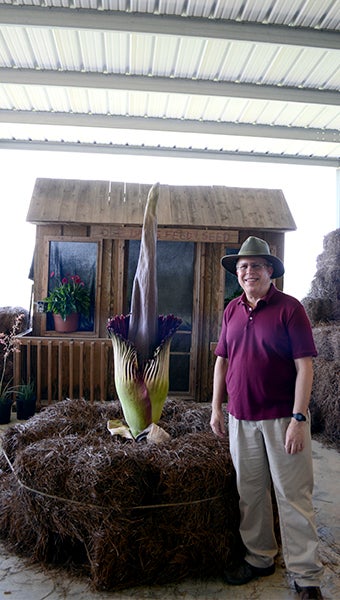Rare plant blooms in Poplarville
Published 7:00 am Friday, July 1, 2016

BLOOMING: Spike, a rare titan arum plant, has begun blooming at the MSU Extension Center in Poplarville.
Photo by Julia Arenstam
A rare plant is currently blooming at the Mississippi State University Extension Center in Poplarville.
The titan arum plant, called Spike, showed signs of its first bloom early this week.
The rare plant, native to the Sumatra island in Indonesia, typically grows in a rainforest environment, which has been simulated in Mississippi via a greenhouse at the extension center, said Gene Blythe, the associate research professor responsible for caring for Spike.
Spike is about nine years old and this is the first time it has bloomed, said Blythe.
“It’s the first one we’ve had,” said Blythe. “It’s very rare.”
The MSU extension center in Poplarville has housed Spike in one of their greenhouses for about seven years.
Titan arum plants, also called amorphophallus titanium, only bloom once every several years, said Blythe.
The titan arum plant has the largest flower in the world, but it is actually the largest inflorescence plant in the world, said Blythe, meaning it is a cluster of flowers on a branch.
Buried inside the outer petal, or spathe, lies the actual flowers of the plant, said Blythe.
The inner column on the plant is called the spadix. As part of its thermogenic chemical structure, it generates heat and emits chemicals that smell like rotting flesh, said Blythe.
The smell is emitted to attract insects, like flies and beetles, for pollination, said Scott Langlois, who works for the MSU Extension Center.
Insects are attracted to the smell and fly into the inner chamber where the small, petal-less flowers are pollinated and hopefully produce seeds, said Blythe.
Before the plant reaches this stage, it goes through a series of cycles where the pit grows a single leaf, about the size of a small tree, before that too dies and another one grows in its place, said Langlois.
Spike went from growing four inches a day, to two, then one and when it showed no growth Blythe said he knew it was going to bloom soon.
Once fully bloomed, Spike is only expected to be open for about 24 hours before becoming dormant for two to three months.
After the bloom and the spadix have fallen, the plant will be used for research, said Blythe.
Spike will undergo a series of chemical and DNA analysis so that scientists may discover something new about the species, said Blythe.
Every year, Spike has been shown to school kids on field trips to inspire careers in science, said Blythe.
The University of Southern Illinois also has a titan arum plant blooming this week. Though, Blythe said it is still unknown whether these plants always bloom around the same time of year.
Spike is on display at the extension center in Poplarville until its blooming has ended, then it will be moved back into the greenhouse.

GROWTH: Dr. Gene Blythe, an assistant research professor at the MSU Extension center in Poplarville, has been caring for Spike the titan arum plant for seven years.
Photo by Julia Arenstam




